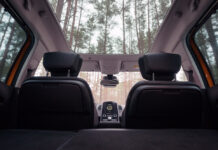A car consists of a welded frame with parts attached in such a way that they can be detached. Attachment mainly consists of bolts and clips. In the past a crash car had to be reported as such if its chassis was bent as a result of an accident. This is no longer the case.
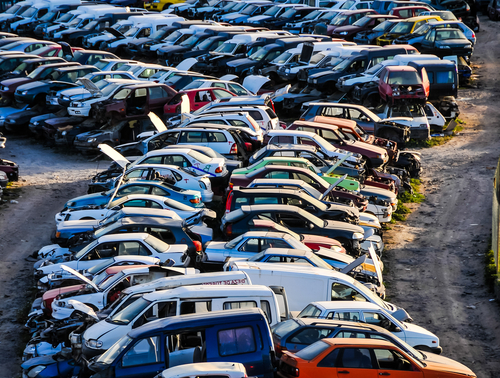 When a car has been involved in an accident, it is a crash car.
When a car has been involved in an accident, it is a crash car.
Distinction is made between reportable and non-reportable accident damage.
An unequivocal definition has not been established up till now.
This companion serves as a guide on what to observe with respect to a car’s history when considering a purchase.
Non-reportable accident damage
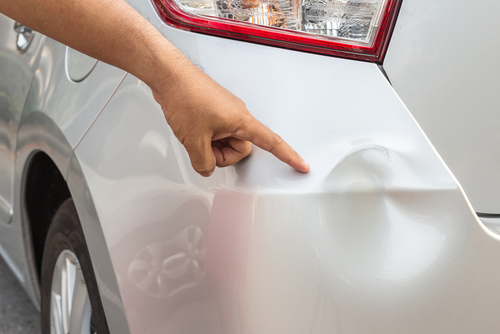 It is widely accepted that minor dents or scratches do not have to be reported.
It is widely accepted that minor dents or scratches do not have to be reported.
Also damaged lighting, side mirrors or other glass components do not require reporting if damage can be repaired by replacing those parts.
Accident damage that can be easily repaired
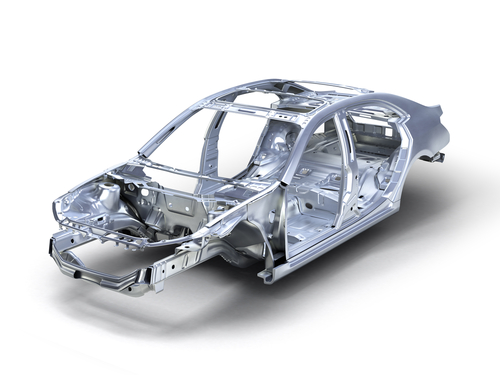 Accident damage is easily repaired as long as the frame is not bent. The frame consists of roof, underbody, the A-, B- and C pillars, the front and the rear including fenders. As long as the damage is limited to the parts that can be loosened, repair is very simple: fenders, bonnets, doors, boot lids and bumpers are simply screwed off and replaced by fitting new or used parts. This can be done in the home garage.
Accident damage is easily repaired as long as the frame is not bent. The frame consists of roof, underbody, the A-, B- and C pillars, the front and the rear including fenders. As long as the damage is limited to the parts that can be loosened, repair is very simple: fenders, bonnets, doors, boot lids and bumpers are simply screwed off and replaced by fitting new or used parts. This can be done in the home garage.
Only for professionals: damage to the frame
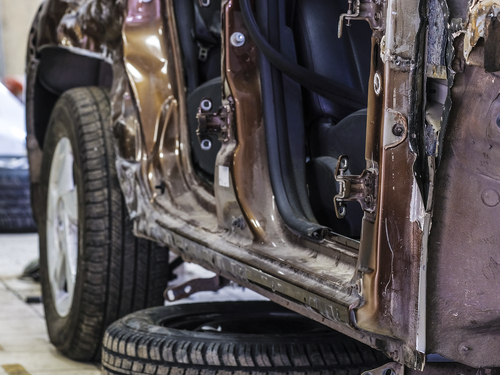 If frame damage compromises the car’s stability, it can only be saved by professional repair. This is not a case of a minor dent in the rear fender which can always be dented out, filled and painted. If the car chassis is “warped” its repair with home tools is not possible. The consequences of a bent frame are:
If frame damage compromises the car’s stability, it can only be saved by professional repair. This is not a case of a minor dent in the rear fender which can always be dented out, filled and painted. If the car chassis is “warped” its repair with home tools is not possible. The consequences of a bent frame are:
|
– doors and lids no longer close |
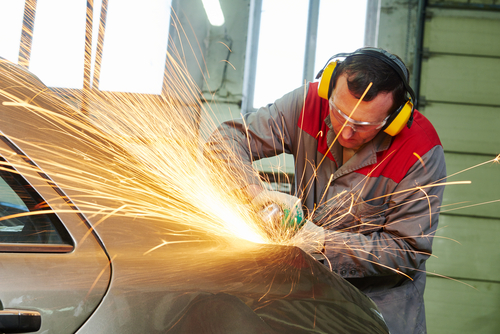 A damaged or unprofessionally repaired frame makes a car unfit for use. It is no longer safe for traffic and must be parked until a bodywork repairer has straightened it. This requires the use of a bodywork straightening bench. And even if the car can be pressed in its original shape, it will remain considerably less stable than before the accident. Often, a professional repair involves the replacement of separate carrier plating and beams. A local garage is not always sufficiently equipped for this kind of repair. In short: a car with frame damage is often only fit for use as a supplier of components.
A damaged or unprofessionally repaired frame makes a car unfit for use. It is no longer safe for traffic and must be parked until a bodywork repairer has straightened it. This requires the use of a bodywork straightening bench. And even if the car can be pressed in its original shape, it will remain considerably less stable than before the accident. Often, a professional repair involves the replacement of separate carrier plating and beams. A local garage is not always sufficiently equipped for this kind of repair. In short: a car with frame damage is often only fit for use as a supplier of components.
What about buying a crash car?
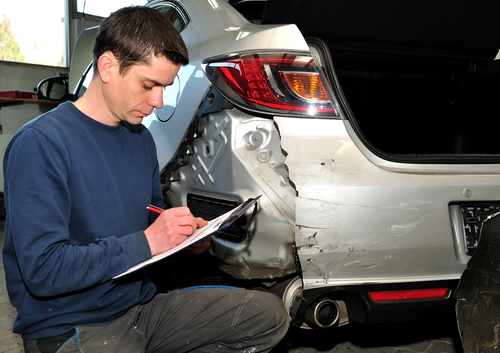 Important when buying a crash car is being informed in advance about the damage and especially the repaired damage. Not mentioning accident damage is an attempt at fraud which can be reported to the police. In any case the purchase can be undone.
Important when buying a crash car is being informed in advance about the damage and especially the repaired damage. Not mentioning accident damage is an attempt at fraud which can be reported to the police. In any case the purchase can be undone.
Dents and scratches can hardly be avoided in the course of a car’s life span. You should be realistic: the probability of a car getting a dent in the course of its existence is rather high. If on occasion of a purchasing inquiry an immaculate scratch- and dent-free car is presented, be cautious. Very probably something is being concealed. An inquiry is insufficient. The accident-free state of the car should explicitly be mentioned in the purchase contract of the car. “Checked and approved” or similar expressions are insufficient to determine whether the car is actually accident-free. Without explicit statement, the accident-free state of the car is generally assumed if it doesn’t say otherwise. Nevertheless only the proper passage gives the necessary legal certainty.
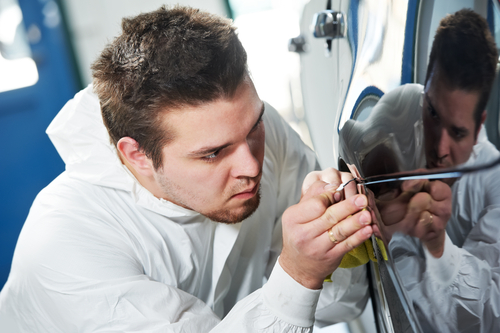 There is no general answer to the question whether a crash car can be bought. If you are looking for a cheap used car, dents and scratches should even be welcomed to a certain extent. They considerably lower the residual value of the car and can be easily repaired. If it is an expensive luxury car, more extensive damage can be accepted – on condition that you have the means for professional repair. Principally, the residual value is based on its accident-free state. The residual value can simply be mentioned online and is a strong argument in determining the purchase price.
There is no general answer to the question whether a crash car can be bought. If you are looking for a cheap used car, dents and scratches should even be welcomed to a certain extent. They considerably lower the residual value of the car and can be easily repaired. If it is an expensive luxury car, more extensive damage can be accepted – on condition that you have the means for professional repair. Principally, the residual value is based on its accident-free state. The residual value can simply be mentioned online and is a strong argument in determining the purchase price.
Found a nice used car – what’s next?
When a second-hand car is freshly painted and shiny, you should be on your guard, as said before. If you suspect a crash car, be very inquisitive. It is recommended to bring a small magnet with a piece of felt attached.
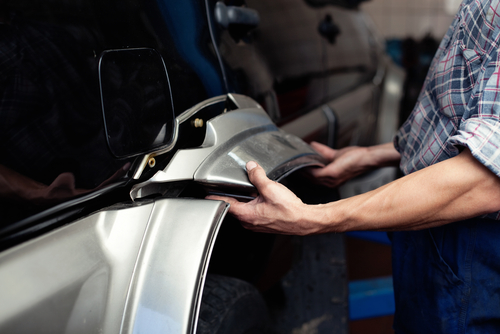 Checking gaps – Stand in front of the car and look at the gap between bonnet and fender. This gap should be the same size everywhere. If it seems bigger on the left while on the right, bonnet and fender appear to be grinding, something is wrong. The same applies to the space between the front fender and the doors. The gap should be even here as well. In its course it should not become wider or narrower.
Checking gaps – Stand in front of the car and look at the gap between bonnet and fender. This gap should be the same size everywhere. If it seems bigger on the left while on the right, bonnet and fender appear to be grinding, something is wrong. The same applies to the space between the front fender and the doors. The gap should be even here as well. In its course it should not become wider or narrower.
Now open all doors, lids and bonnets. If they hang, jam or can only be opened by applying force, they are crooked. Hanging doors or the bonnet resisting shutting are the result of a bent frame.
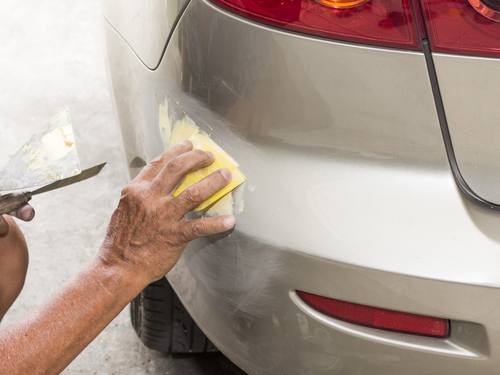 Finding filler – Check the bodywork lines with car doors closed. Stand right in front of the front blinker and look sharply along the side. Undulating spots indicate filling works. Move the magnet over the spot, preferably with the felt cover on the side of the metal. After all, you don’t want to pay for scratching the surface. If there are perceivable differences in the magnetic adherence, you have spotted filler putty.
Finding filler – Check the bodywork lines with car doors closed. Stand right in front of the front blinker and look sharply along the side. Undulating spots indicate filling works. Move the magnet over the spot, preferably with the felt cover on the side of the metal. After all, you don’t want to pay for scratching the surface. If there are perceivable differences in the magnetic adherence, you have spotted filler putty.
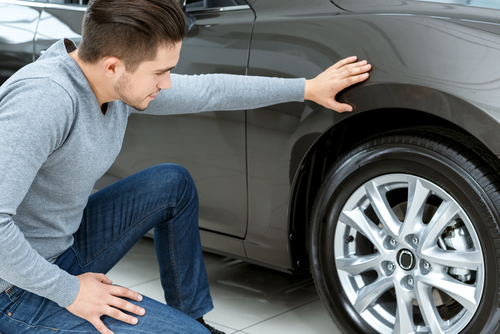 Out of alignment and tell-tale paint traces – Start the engine and turn the steering wheel fully to the right. Look at the tread of the front wheels. If they are worn on one side, the car is out of alignment. This can be a sign of minor as well as major accident damage. Look for traces of paint on the tyres and calipers. If paint has been spilled on occasion of touching up, a crash car is exposed. Repeat the process by turning the wheels to the other side.
Out of alignment and tell-tale paint traces – Start the engine and turn the steering wheel fully to the right. Look at the tread of the front wheels. If they are worn on one side, the car is out of alignment. This can be a sign of minor as well as major accident damage. Look for traces of paint on the tyres and calipers. If paint has been spilled on occasion of touching up, a crash car is exposed. Repeat the process by turning the wheels to the other side.
- Inspect welding spots – Open the bonnet and inspect the front meticulously. Has a new radiator been installed? Is the sub-frame carrying the radiator new as well or possibly “hammered in shape?” In case of frontal collision, the frontal sub-frame has to be welded. Welding spots can be seen on the seams and possibly by the protruding welding thread.
- Triggered airbags? Inspect the interior. Activated airbags leave traces. White dust is a clear sign of airbag activation. Slide the seat to the front and back to look for these particles. Evidently, you need to be very careful tinkering with the dashboard. Slightly pull the airbag cover on the steering wheel. Crash cars often have a fake cover installed. It will become loose quickly and you have exposed the swindler.
- Taking it for a test drive – A short test drives gives further clarity. If the car pulls to one side, the car is misaligned. A broken exhaust roars unmistakably loud. Rattling sounds when braking are a sign of malfunctioning brake pads. This puts you on the track of a crash car. If this was not specifically made clear in advance, we recommend to let go. They are attempting to deceive you and this can turn out to be very expensive.
Selling a crash car
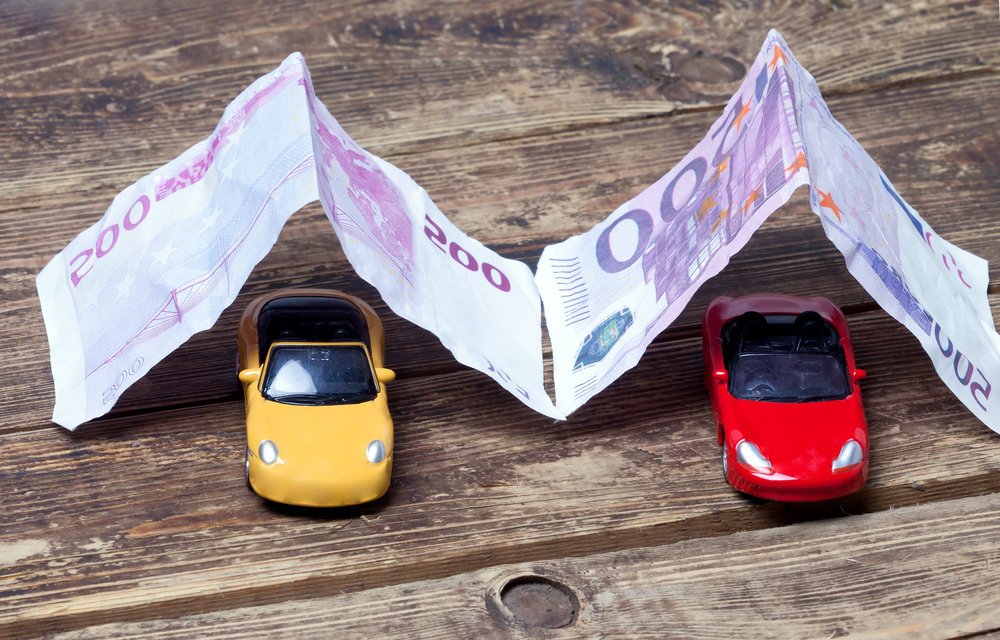 A crash car is an object of trade just like any other object and can be sold without problem if you stick to the rules. If you want to sell your crash car with as little loss of value as possible, you can repair minor damage yourself. Please note: if doors and fenders are replaced, you have to mention this. Photo documentation of the repaired damage creates confidence.
A crash car is an object of trade just like any other object and can be sold without problem if you stick to the rules. If you want to sell your crash car with as little loss of value as possible, you can repair minor damage yourself. Please note: if doors and fenders are replaced, you have to mention this. Photo documentation of the repaired damage creates confidence.
For luxury cars, professional repair by a garage is recommended. The invoices are also a guarantee and considerably reduce the loss of value through accidents. Furthermore, you show yourself to be credible and reliable. This simplifies the sale of car and guards you against unpleasant legal complications.
Alternatively you take the loss of value for granted by selling the car with visible damage. This also gives you a considerable reliability bonus, as you don’t attempt to conceal anything. A potential buyer will certainly value your honesty.
Foto: Nestor Rizhniak, underworld, correct pictures, Freedom_Studio, kvsan, Vereshchagin Dmitry, Dmitry Kalinovsky, loraks, baranq, Nestor Rizhniak / shutterstock.com




 (9 votes, average: 3.67 out of 5)
(9 votes, average: 3.67 out of 5)